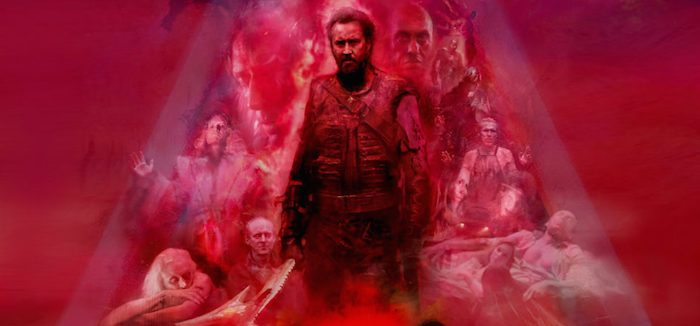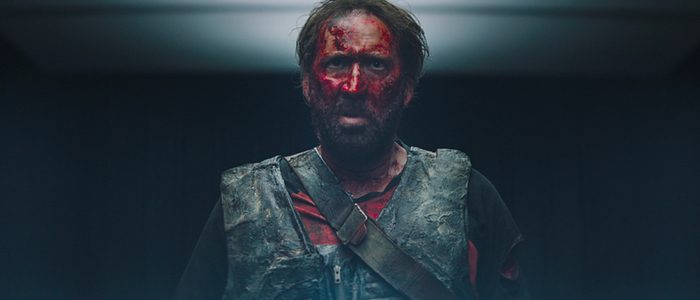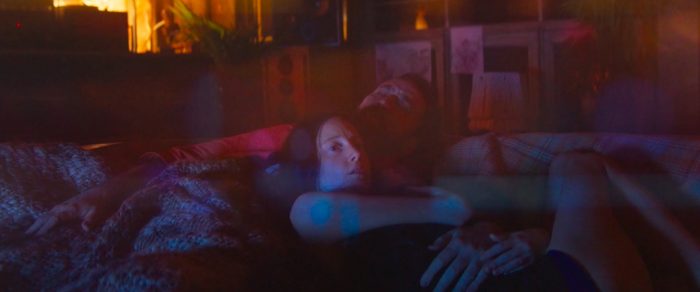‘Mandy’ is a Captivating Reconstruction of the Self – And It Also Has Nicolas Cage Getting in Chainsaw Fights

There are very few filmmakers who can match the energy Nicolas Cage brings to the screen. Werner Herzog is one; his Bad Lieutenant: Port of Call New Orleans, a bad-cop-gone-worse story, pits Cage against his drug-fueled demons and has them breakdance to taunt him. Adaptation, one could argue, traps Cage within creative claustrophobia and makes him force his way out. Perhaps this year’s Mom and Dad comes close, allowing Cage to take a sledgehammer to a pool table while singing the Hokey Pokey. But Panos Cosmatos’ Mandy, in which Cage does more screaming than speaking, may well be the Holy Grail.
The Nicolas Cage Losing His Shit montage on YouTube is creeping up on a million views, and while it’s all too easy to make fun of it, the video also doubles as the show-reel of an actor willing to dive in headfirst unlike most others. Cage creates people that feel like they can’t be contained by a screen, and Mandy is the rare film (the only film, perhaps) that approximates what it must be like to live inside the head of one of his characters. It’s filled to the brim with melancholy energy, in constant motion even during its quietest moments, stripping away layers of meaning and imagery until it furiously smashes them back together. “Finally,” I thought, as Mandy reached its fiery climax, “a film about Nic Cage’s specific brand of sadness.”

A Familiar Story
To put the film’s plot on paper is folly, though I need to do just that for context; it’s exactly what you’d expect from a film where a woman, Cage’s love, becomes the object of a villain’s affection. Deep in the woods in the early ’80s, lumberjack Red (Cage) lives with Mandy (Andrea Riseborough) in what feels like an idyllic setting. Their cabin bedroom may as well be at one with nature, separating them from the trees with thin sheets of glass, as they sleep under the night sky. They share a deep camaraderie, one that’s jeopardized when Mandy is kidnapped by cult leader Jeremiah Sand (Linus Roache) after which, as you may have gauged from the trailer, fights with axes and chainsaws ensue.
Who exactly is doing the kidnapping, though? Jeremiah has regular henchmen (and henchwomen) who follow him on his mission to re-unite with a Saviour, but for a mission as Holy as acquiring Mandy, he enlists demonic bikers that feel like they’ve stepped right out of Hell. At first, it seems like Red is up against supernatural powers, for which he fashions a battle-axe that wouldn’t feel out of place in a space-set B-movie plucked from the era. The reveal, however, of what’s really going on — less a “twist” and more a necessary deflation — sets the story in a whole new context.
The satanic bikers in question are simply a gang of couriers who had a particularly bad acid trip (if anything is “supernatural,” it’s the strength of the drugs they take) and the cult in question isn’t really a “cult” as we’d expect, but rather, a group of Evangelists contorting Christian doctrine for selfish gains. Yet the meaning behind their every word and the ways in which they see themselves are their own form of cult-like construction; they have, albeit through grounded means, built themselves anew and in the mold of supernatural horror — like a deconstruction of Hellraiser wherein Pinhead was a regular guy with a tortured existence.
That same torment is paid forward, finding its way to Mandy and eventually to Red, who become victims of this construction in ways that rob them of the very love that separates them from Jeremiah and his cult-like control. Still, nothing I’m describing here feels like Mandy. Thus far, I’ve just described what happens in it. How it happens is the real story.

A Haunting Texture
Mandy was one of the last films scored by Jóhann Jóhannsson, who passed away this year. It’s a film that bides its time — the title doesn’t appear on screen until an hour and fifteen minutes in — but it fills the spaces with enveloping synth sounds in the interim, notes that weed their way into every crack of the characters’ fractured psyches. It’s overwhelming in the most beautiful way; each scene begins at an emotional distance, before creeping forward like a moving oil painting where the sky itself is contorting, struggling to form a picture (or perhaps, fighting to remain abstract) ending up, usually, on a closeup of Cage in anguish. Benjamin Loeb’s cinematography colours even the obscuring fog, washing it with blood, as if turning blockades to rational thought (whether substance or impulse) into violent works of art worth getting lost in.
As we snake our way down the winding mountainside, the music begins to feel like the vibrations of the forest itself (if not the celestial dances in the film’s brief animated scenes), as if California were Mirkwood or some fantastical location, and these aggro simpletons were forces of pure evil from beyond the veil… even though the film’s text emphasizes that they are decidedly not.
As Red fetches his hidden crossbow “The Reaper,” his friend (Bill Duke) lays out the underwhelming origins of the druids that kidnapped Mandy for Jeremiah. While they were summoned through seemingly supernatural means — a Satanic conch that, when seen through the eyes of the cult members, flashes green — they’re just some assholes who can’t keep reality straight. When Red ends up at one of their hideouts, he’s surrounded by discarded takeout boxes that haven’t been cleaned for months. Red even gets a small whiff of what they’ve been huffing, resulting in a volcanic drug trip that puts these bike-demons and their pain in context; you almost feel bad for them.
And yet, these drugged-up dummies with their cobbled-together Slipknot aesthetic still feel the greatest of all evils. The meaning prescribed to them is not simply a supernatural aura, nor even malicious intent accentuated by spikes and chains. Rather, it’s their position within Red and Mandy’s story. These villains exist to separate halves of a whole, robbing Red and Mandy of each other’s love and placing them instead in the hands of those who would abuse the very idea of love in the first place.
Continue Reading A Closer Look at Mandy >>
The post ‘Mandy’ is a Captivating Reconstruction of the Self – And It Also Has Nicolas Cage Getting in Chainsaw Fights appeared first on /Film.
from /Film https://ift.tt/2O7tZUw
No comments: